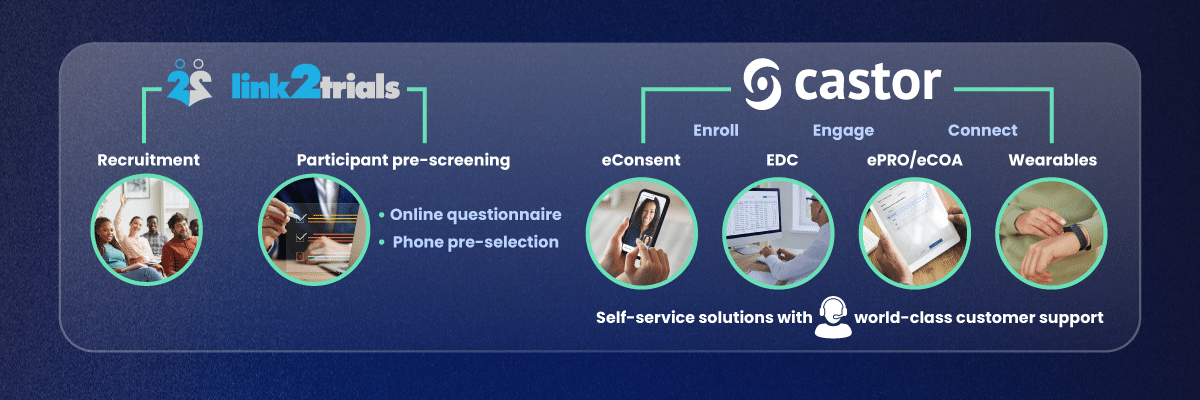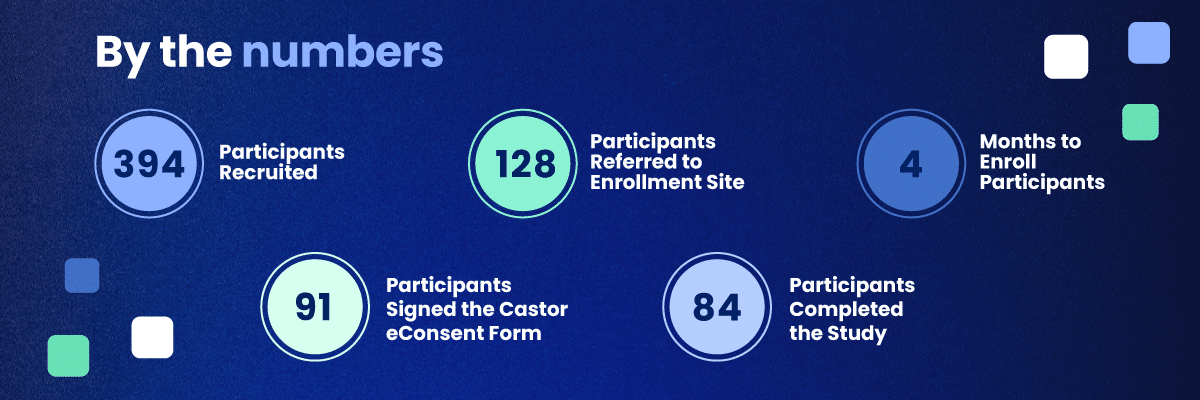It’s estimated that a quarter to a third of adults in the U.S. have urinary incontinence in some form. That’s why Essity, a global health company known for household brands such as Tork and Purex, created a bladder sensor using ultrasound to support in the prevention of urinary incontinence by continuous monitoring of the urinary bladder.
With initial feasibility studies quickly moving forward on its innovative bladder sensor, Essity needed to design and conduct a large-scale study using its own device.
-
Industry
Medical Device Companies
-
Challenge
Essity needed to recruit participants for a decentralized clinical trial to test a bladder sensor prototype and keep them engaged throughout the entire study.
-
Solution
Essity deployed virtual methods through strategic partnerships to recruit and retain participants, leveraging technology to streamline the process of collecting consent and analyzing patient data.
-
Result
Essity had a total of 84 enrolled participants who completed the study within the desired timeline. The successful recruitment and retention of patients paired with data capture helped create a life-improving treatment.
Challenges
- Recruit a significant number of participants who fit inclusion criteria
Essity needed to recruit and enroll patients 35-75 years old. Patient recruitment can account for 30% of clinical timelines, and each day of delay can represent over $37,000 in operational costs to sponsors. - Decrease the number of in-person patient visits
Since it occurred during the COVID-19 pandemic, the study design needed to limit travel and in-person contact for participants. This was especially important since the trial would likely include several elderly patients due to the age criteria and condition being studied. - Ensure a positive and convenient user experience for all participants
Essity also needed to keep its patient population engaged throughout the duration of the clinical trial. In typical trials, only 1 out of 20 patients who respond to recruitment promotion complete the study, with only 1 out of 5 showing up for initial screening.
Creating integrated patient experiences
Essity partnered with Castor and Link2Trials to construct a hybrid clinical trial ecosystem to meet their needs. Here’s how they did it.
- Online recruitment of patients
Link2Trials handled the online recruitment for the study and recruited 394 subjects who registered for this trial. Online ads targeted towards potential patients were leveraged, sending them to a custom landing page for pre-screening questionnaires. From there, potential participants had a phone call with the Link2Trials medical call team. If still eligible and interested, they were transferred to Castor for eConsent. Castor’s open API enabled seamless interoperability between its own platform and the Link2Trials platform. This connection allowed patients to enroll without re-entering data. - Virtual enrollment
The virtual enrollment process included seamless onboarding of patients remotely through video-enabled informed consent. This was ideal for addressing the need to reduce in-person contact during the COVID-19 pandemic, and Castor’s platform made for an easy enrollment experience for participants. - On-site measurements
On-site measurements were accomplished via the Castor EDC platform that connects all natively integrated DCT components through RESTful APIs, supporting direct data capture in the field.
Taking the ‘perfect match’ into consideration, social media recruitment and pre-screening done by Link2Trials and Castor’s eConsent/eCRF tools helped to increase the rate by at least 2x. [It would have been] even higher if the site would have had the chance to manage all patients.
Sandra Tobisch, Senior Clinical Trial Manager at Essity
Optimized patient journey
In the end, 84 participants enrolled and completed the study. The entire recruitment process took just four months. With no site visits required for enrollment and access to a connected platform with all trial components in one place, Essity created a clinical trial ecosystem that was accessible to all participants, including the elderly.
Creating the right ecosystem of technology and services allowed Essity to streamline its clinical operations while also making it easier for participants to navigate the journey from start to finish. Best of all, the completed research can inform future innovation to help people cope with incontinence.
It was easy to create our clinical trial workflow. Integration and training with external partners were effortless. Usability and light coding were essential to us. We were able to test and build our studies with minimal support and admin
Arne Böhling, Clinical Affairs Director at Essity
Essity chose Castor as the sole provider for all in-house clinical trials.

